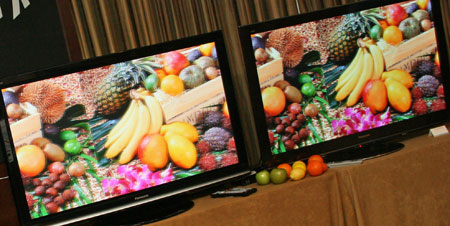Panasonic 2010 Product Showcase

That doesn't mean Panasonic's 3D-capable plasma, the flagship VT25, was a no-show—it just wasn't showing 3D. Instead, company reps extolled the virtues of the technology that allows 3D and how it also improves 2D images, which was quite evident in a side-by-side comparison of the VT25 and the 2009 G10 being fed the same HD signal from a hard-disk server. (Unfortunately, it's not so evident in the photo above with the VT25 on the right, but believe me, it was in person.) The blacks on the VT25 were clearly darker than on the G10, and motion detail was quite a bit sharper.
The technology that allows the VT25 to reproduce 3D includes Dual Scan pixel addressing, which puts addressing circuitry at the bottom of the screen in addition to the corresponding circuitry found at the top of all plasma screens. This means that the pixels can be addressed twice as fast as conventional plasmas, allowing an overall frame rate of 120Hz—60Hz for each eye. It also means that 2D content can be displayed with more subfields, resulting in better grayscale and smoother gradations, especially in dark scenes.
Another critical factor in the ability to display 3D is a new phosphor that turns on and off much faster than ever before—in fact, the glow of the green and red phosphors persists only one third as long as previous formulations. (The blue phosphor already persists much less than red or green, so it didn't need updating.) In addition to allowing 3D, this also improves 2D resolution by greatly reducing crosstalk between subpixels.
We've been hearing a lot about Panasonic's "Infinite Black" plasmas, which include the VT25, G25, and G20 lines. Considering that Panasonic was going to make plasma panels for Pioneer before the Kuro plug was pulled, I asked if Panasonic had acquired any Kuro technology that might contribute to the Infinite Black models. A company rep said that some Pioneer plasma engineers did make the move to Panasonic, but he didn't know of any specific Pioneer technologies that were being used in the 2010 models.
So how did Panasonic achieve lower black levels than last year, as demonstrated in the side-by-side demo at the event? For one thing, there's a new "louver filter" on the front of the panel that is said to reduce ambient-light and internal reflections as well as improve contrast and sharpness in bright environments. Also, a new pre-discharge control reduces the pre-discharge voltage on each pixel to lower the black level in all models from the S2 up to the VT25, which also sport a new and improved NeoPDP panel that is said to lower blacks and reproduce fully 1080 lines of moving-picture resolution.
For the sake of completeness, the new Panasonic plasmas include six lines; from top to bottom, they are:
- VT25 (50, 54, 58, 65 inches)
- G25 (42, 46, 50, 54 inches; $1200-$2000)
- G20 (50, 54 inches)
- S2 (42, 46, 50, 54, 58, 65 inches; $900-$2800)
- U2 (42, 50 inches; $600, $800)
- C2 (720p; 42, 46, 50 inches; $600-$800)
In other news, Panasonic is expanding its lineup of LCD TVs to the 42-inch size range. Also, two of the LCD lines—U25 and D2—are 120Hz, and the D2 uses LED edge lighting. All but one model in the new line use IPS (in-plane switching) LCD panels to achieve wider viewing angles. No pricing was announced, and the new LCD sets will be available between March and May.
Blu-ray players were not forsaken, with six new models, including two portables and one BD/VHS combo unit in addition to three dedicated units, the DMP-BD45, BD65, and BD85. Sadly, there was no info offered on the DMP-BDT350 3D player, which we should see at the next press event.
Perhaps the most important Blu-ray announcement was that all three new dedicated models boot up in less than half a second, compared with about 9 seconds for the BD60, and they load and start playing a Blu-ray disc in less than 14 seconds. Also of note is the Viera Cast WiFi capability of the BD65 and BD85 with a dongle that uses a new, proprietary antenna said to be more sensitive than other players' antennas.
The BD85 offers improved video performance with a new Adaptive High Precision 4:4:4 processor designed to produce better color and edge detail—in fact, it's the same chip as found in the BDT350 3D player. The BD85 also provides a better grade of audio components, an HDMI Jitter Purifier for better HDMI sound, and a Digital Tube Sound Simulator that—you guessed it—simulates the sound of a tube amplifier.
- Log in or register to post comments





























































